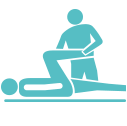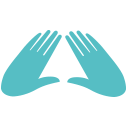Heal Your Sports Injuries with Our Sports Rehabilitation Program
Have you had to sit on the sidelines for the last few practices or games because of a sports injury? Did you get hurt back in college, avoiding a doctor, and letting the injury heal on its own, but the bone or muscle was never quite the same? Support your body, your sports goals, and your recovery with our sports rehabilitation program.
Why Should You Treat Sports Injuries?
Sports injuries, whether new or old, can limit your current physical activity and set the course for bigger problems later in life. This is true for both bones and muscle tissues.
Sports Injury: Bone
If a bone doesn’t heal correctly after a severe strain or break, it can promote incorrect movement patterns. In turn, this can cause muscle strain in other areas of your body, leading to soreness, tightness, pain, and more injuries. In other words, one injury can set off a chain reaction that impacts the rest of your body.
A great example of this is an ankle break, which is one of the most common sports injuries among athletes. If the ankle does not heal properly, it can cause muscle tightness in the calf muscle, which puts more strain on the kinetic chain moving up the body: your hamstrings, glutes, lower back, shoulders, and neck. You could experience increased lower back pain and headaches. Eventually, if you attempt to perform an exercise like a squat, you could injure yourself further.
Sports Injury: Muscle
Tearing a muscle can keep you out of both training and events for months. Even worse, if you tear connective tissue, you may have to take the year off as it takes three times as long to heal compared to muscle tissue.
Muscle-based sports injuries can also cause future complications due to overcompensation or when one muscle group takes on the workload of another. An over-worked muscle group has a higher risk of injury, which creates a vicious cycle of never properly healing.
Why take a chance like that, especially if it means more time out of your sport? Avoid further complications and get that sports injury taken care of with our sports rehab program.
Treating Sports Injuries
Ravenswood Chiropractic & Wellness Center treats all types of acute or recent sports injuries, but we also help to resolve lingering injuries from the glory days in your chosen sport.
No matter your experience, age, or sport, we can help you feel like an athlete again. Here’s a breakdown of how we treat our patients, focusing on both recovery and guiding them toward better progress in their sport.
Consultation
It all starts with understanding more about you and your sports injury. We don’t believe in a one-size-fits-all approach to treating patients. Each and every recovery program is unique to the individual, which is why the initial consultation is so important. We will discuss the cause of the injury and the pain points from the injury with you.
The consultation will also involve monitoring your movement patterns to see what else is going on behind the scenes. After this extensive consultation, our team will create a one-of-a-kind rehabilitation program based on physical therapy that fits your needs and goals.
 Physical therapy is an umbrella term that encompasses many types of treatment. While you may not necessarily need all types of physical therapy, here are a few you can expect at different times during your recovery:
Physical therapy is an umbrella term that encompasses many types of treatment. While you may not necessarily need all types of physical therapy, here are a few you can expect at different times during your recovery:
 Chiropractic: Manipulation of the skeleton is key to setting the body on the course for recovery. Sports injuries can happen throughout the body and they often are left to heal on their own. Whether you have a broken bone or slipped disc, your body will need guidance in order to properly heal. Chiropractic adjustments can help the body to heal as it should while alleviating symptoms related to the injury such as soreness and pain.
Chiropractic: Manipulation of the skeleton is key to setting the body on the course for recovery. Sports injuries can happen throughout the body and they often are left to heal on their own. Whether you have a broken bone or slipped disc, your body will need guidance in order to properly heal. Chiropractic adjustments can help the body to heal as it should while alleviating symptoms related to the injury such as soreness and pain.

Acupuncture: Although it’s been used in Eastern Medicine for thousands of years, acupuncture has only recently come into the practice of western medicine. Using tiny needles to stimulate nerves, acupuncture has been shown in multiple studies to alleviate the pain associated with a sports injury, especially in the lower back. Other experts suggest that acupuncture can improve the healing process, allowing the body to recover faster.

Massage: Sure, it feels great to have a relaxing massage to melt away tension, but massage can also be used as a powerful healing tool for sports injuries. Deep tissue massage or sports massage involves a certified massage therapist manipulating the muscle tissue in order to break up adhesions, more commonly known as knots. In the same fashion of a chiropractor guiding a joint down the path to recovery, a massage therapist can help the muscle tissue to heal properly while alleviating soreness and pain.
Functional Medicine: Healing occurs from the inside out. All of the bodywork above takes place outside of it, but it’s just as important to focus on healing from the inside. Nutrition is the key to promoting healing in the body. After a sports injury, the demand for proper nutrition will skyrocket as the body seeks the proper nutrients to promote healing. We provide customized meal plans that are ideal for recovery. Our team can also give recommendations for natural supplements that can complement your nutrition plan.
All Healed Up – Time to Get Stronger
Once you’ve completely healed from your sports injury, we can help you advance with your sport and fitness goals. Our post-rehab program focuses heavily on preventing further sports injuries while improving your athletic performance.
Strength Training: While the term strength training is often associated exclusively with the weight room, it is more like an umbrella term that involves different types of exercises that all focus on making your body stronger.
Our expert personal trainers will cycle you through a variety of strength training exercises such as bodyweight, resistance training (e.g., resistance bands), and cardiovascular. Strength training will help to build lean muscle tissue while improving connective tissue and bone density.
Balance and Coordination: One of the best ways to prevent future injuries and increase your athletic ability for years to come is by focusing on your balance and coordination. Did you know there are three planes of motion? Most people move and exercise in only two: the sagittal (front to back) and frontal (side to side). This is okay, but if you want to dramatically increase your balance, mobility, and coordination, it’s important to move in the transverse plane as well.
The transverse plane involves rotational movements such as a woodchopper or swinging a weight from the top right side of your body to the bottom left side. Working in the three planes of motion, we’ll challenge your central and muscular nervous systems by incorporating instability into seemingly easy workouts. The result: better balance, stronger performance.
Sports-Specific: Whether you’re a young athlete or a sports veteran looking to get back into the game, we can help you train specifically for your sport. Our personal training staff is skilled in sports-conditioning drills that can help to improve your performance in all popular sports such as football, soccer, and basketball.
Even if you have never sustained a sports injury, Ravenswood Chiropractic & Wellness Center can help you avoid potential injury and dramatically improve your sports performance.
Get Well, Get Better with our Sports Rehab Program
Let us help you get back on the field, in the weight room, or in the pool with our sports rehabilitation program. Give us a call at 773-878-7330 to schedule a consultation. We can pinpoint the problem, make sure it heals properly, and help you progress to achieve your fitness goal, no matter how big or small.
Dr. DeFabio D.C. is a highly regarded chiropractor in Chicago who focuses on helping his patients achieve optimal health and wellness. He takes a holistic approach to care, treating symptoms and addressing underlying issues to promote long-term healing. Dr. DeFabio D.C. is passionate about empowering his patients to take control of their health and live their best lives. You can find him surfing, skateboarding, and volunteering at the Lakeview Food Pantry when he’s not in the office.










